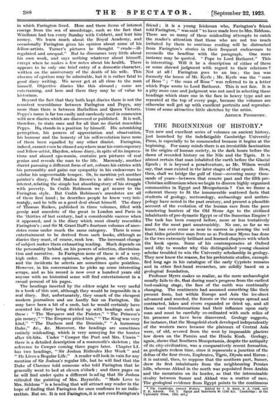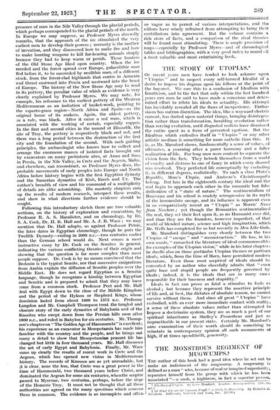THE BEGINNINGS OF HISTORY.*
THE new and excellent series of volumes on ancient history, just launched by the indefatigable Cambridge University Press, is especially to be commended because it begins at the beginning. For many minds there is an irresistible fascination in the origins of human society, in the dark hours before the dawn of recorded history on the Nile and the Tigris. It is almost certain that man inhabited the earth before the Glacial Epoch ; it is beyond a peradventure, as Mr. Wilson would say, that man existed in the later stages of that epoch. How, then, shall we bridge the gulf of time—covering many thou- sands of years—between that remote past and the fifth pre- Christian millennium when we begin to discern highly organized communities in Egypt and Mesopotamia ? Can we frame a coherent theory to fit the innumerable scattered facts that students of geology, meteorology, archaeology and anthro- pology have noted in the past century, and present a plausible account of the evolution of the human race from the poor wandering hunters of the Old Stone Age to the civilized inhabitants of pre-dynastic Egypt or of the Sumerian Empire ? The task has been essayed before, more or less tentatively and for the most part amateurishly. No one, so far as we know, has ever come so near to success in piercing the veil that hides primitive man from us as Professor Myres has done in the two extremely brilliant and learned chapters with which the book opens. Some of his contemporaries at Oxford used idly to wonder why this distinguished' young classical scholar troubled to win the University scholarship in geology. They now know the reason, for his prehistoric studies, exempli- fied long ago in his catalogue of the early Cypriote remains and in other first-hand researches, are solidly based on a geological foundation.
Professor Myres makes us realize, as the mere archaeologist usually fails to do, that during man's progress from the earliest tool-making stage, the face of the earth was continually changing. The continents had assumed something like their present form, but within Europe and Asia the ice-sheet advanced and receded, the forests or the swamps spread and contracted, lakes and rivers expanded or dried up, and all these vast transformations had their influence upon early man and must be carefully co-ordinated with such relics of his presence as have been discovered. Geology suggests, for instance, that the Mongoloid stock developed independently of the western races because the plateaux of Central Asia were, of old, severed from the west by impassable glaciers low down on the Pamirs and the Hindu Kush. Geology, again, shows that Southern Mesopotamia, despite the antiquity of its city-civilization, was a comparatively recent formation, as geologists reckon time, since it represents a junction of the deltas of the four rivers, Euphrates, Tigris, Diyala and Karlin ; it is natural, then, to suppose that the southern part, Sumer, drew its first inhabitants from the neighbouring Persian hills, whereas Akkad in the north was populated from Arabia and the mountains on its border, so that the interminable rivalry between Sumer and Akkad was a matter of race. The geological evidence from Egypt points to the continuous
• The Cambridge Ancient 'Hiders,. Edited by 3. B. Bury, 8. A. Cook, and F. E. Adcock. Vol. L Egypt and Babylonia to 1580 B.C. Cambridge : at the University Press. [35s. net.] presence of man in the Nile Valley through the pluvial periods, which perhaps corresponded to the glacial periods of the north. In Europe we may suppose, as Professor Myres shrewdly remarks, that the approach of the ice stimulated the very earliest men to develop their powers ; necessity is the mother of invention, and they discovered how to make fire and how to make hunting weapons to kill fur-bearing animals simply because they had to keep warm or perish. These hunters of the Old Stone Age liked open country. When the ice receded and the forest spread over Europe, palaeolithic man fled before it, to be succeeded by neolithic man, of a different stock, from the forest-clad highlands that centre in Armenia and thrust eastward into Persia and westward into the heart of Europe. The history of the New Stone Age may be read in its pottery, the peculiar value of which as evidence is very clearly explained by Professor Myres. We may note, for example, his reference to the earliest pottery of the Western Mediterranean as an imitation of basket-work, pointing to the esparto-grass region—North Africa and Spain—as the original home of its makers. Again, the oldest pottery, as a rule, was black. After it came a red ware, which is associated with the working of metals, especially copper. In the first and second cities in the mound at Hissarlik, the site of Troy, the pottery is respectively black and red, and there was a long period between the destruction of the first city and the foundation of the second. With such guiding principles, the archaeologist who knows how to collect and arrange the enormous masses of isolated facts brought out by excavators on many prehistoric sites, at Anau and Susa in Persia, in the Nile Valley, in Crete and the Aegean, Malta, and elsewhere, can reconstruct, as Professor Myres does, the probable movements of early peoples into Europe and North Africa before history begins with the first Egyptian dynasty and the Sumerian dynasties of Kish, Erech and Ur. The author's breadth of view and his command of a multiplicity of details are alike astonishing. His masterly chapters sum up the results of modern research, interpret these results, and show in what directions further evidence should be sought. Following this introductory sketch there are two valuable sections, on the history of exploration and excavation, by Professor R. A. S. Macalister, and on chronology, by Dr. S. A. Cook, Dr. H. R. Hall and Mr. A. J. B. Wace ; we may mention that Dr. Hall adopts, as against Professor Petrie, the later dates in Egyptian chronology, though he puts the Twelfth Dynasty—ending in 2000 B.C.—two centuries earlier than the German school would do. Next comes a most instructive essay by Dr. Cook on the Semites in general, indicating the various conflicting theories of their origin and showing that the question is far more complex than most people suppose. Dr. Cook is by no means convinced that the Bedouin is the typical Semite, nor that successive emigrations from Arabia explain the diffusion of Semitic peoples over the Middle East. He does not regard Egyptian as a Semitic language, though he recognizes a kinship between Egyptian and Semitic and is prepared to admit that they may have come from a common stock. Professor Peet and Mr. Hall Seal with Egypt down to the close of the Middle Kingdom and the period of the Hyksos or Shepherd Kings, whose dominion lasted from about 1800 to 1575 B.c. Professor Langdon and Mr. Campbell Thompson treat the tangled and obscure story of the early dynasties of Babylonia and of the -Kassites who swept down from the Persian hills soon after 1800 n.c., and ruled in Babylon for six centuries. Mr. Thomp- son's chapter on "The Golden Age of Hammurabi" is excellent; his experience as an excavator in Mesopotamia has made him familiar with the country and the people, and he brings out many a detail to show that Mesopotamian peasant life has changed but little in four thousand years. Mr. Hall discusses the art of early Egypt and Babylonia. Finally, Mr. Wace sums up clearly the results of recent work in Crete and the Aegean, which has opened new vistas in Mediterranean history. The records of Knossos are as yet unreadable, but it is clear, none the less, that Crete was a great power in the time of Hammurabi, two thousand years before Christ, and dominated the Aegean for some six centuries, whenthe sceptre passed to Mycenae, two centuries, perhaps, before the siege of the Homeric Troy. It must not be thought that all these -authorities are agreed on the many questions which concern Them in common. The evidence is so incomplete and often
so vague as to permit of various interpretations, and the editors have wisely refrained from attempting to bring their contributors into agreement. But the volume contains a rich store of facts, and a comparison of the rival theories will be found most stimulating. There is ample provision of maps—especially by Professor Myres—and of chronological tables and bibliographies, with a very good index to round off a most valuable and most entertaining book.







































 Previous page
Previous page